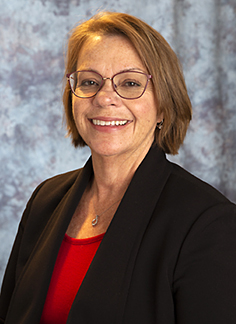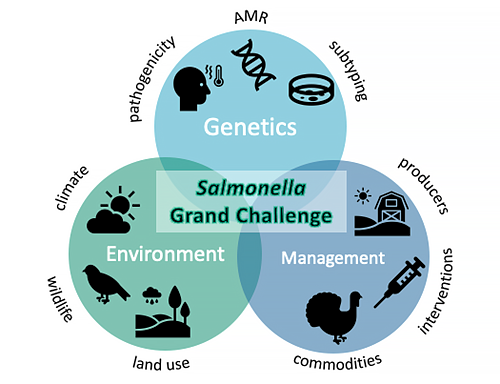
Salmonella: A Grand Challenge for Food Safety
 |
Dr. Kim Cook is a National Program Leader for ARS's Nutrition, Food Safety/Quality program. She spoke with Under the Microscope about a newly-launched Grand Challenge initiative to combat the dangers of Salmonella in the U.S. food supply. |
Welcome Dr. Cook to Under the Microscope.
UM: Why is Salmonella a problem?
KC: Salmonellosis is the second leading cause of foodborne illness in the U.S. The Centers for Disease Control and Prevention estimates that it causes over 1.35 million illnesses, 26,500 hospitalizations, and nearly 420 deaths annually. These numbers are complicated by the large number (more than 2,400) of Salmonella serotypes — that is, distinct strains of a microorganism; the global occurrence of the organism; its broad range of pathogenicity and the fact that it can survive in most animals without causing disease. To combat its harmful effects, USDA is launching a "Grand Challenge" initiative to combat Salmonella.
UM: Why is USDA expanding its work on Salmonella now?
KC: Rather than expanding our work, I would say that the Grand Challenge is consolidating and optimizing our work to address this persistent issue in new, integrated approaches that have never been attempted before. ARS has a unique ability to bring together expertise from across our programs to address this priority need in a way that no other program can. This project brings scientists and others (chemists, ecologists, animal scientists) from across ARS together to unify the work and think in new ways about how to combat Salmonella.
UM: What are the goals of the initiative?
KC: We want to integrate research and to learn more about how and where Salmonella causes the highest risk to meat and poultry products. We also want to utilize this information to develop better tools for meat and poultry producers that can help to make decisions sooner, which will ultimately prevent a Salmonella problem.
The ARS team will enhance ongoing research by adopting a trans-disciplinary approach, coordinating research to identify larger trends, emerging threats, and novel Salmonella mitigation strategies. This effort will enhance our ability to identify on-farm strategies to reduce the risk of Salmonella in final meat and poultry products.
UM: How do people get Salmonella, typically? What are the most common sources?
KC: It's transmitted through the consumption of contaminated food products, including raw or under-cooked poultry, eggs, meat, raw or unpasteurized dairy products, and fruits and vegetables. It can also be transferred from handling pets — particularly some birds and reptiles.
UM: What are some common misperceptions about Salmonella?
KC: Consumers may not understand the difference between various types of bacteria and their level of resistance to preventive practices. There are types of bacteria that survive under extreme conditions and adapt to their environment. This is true for Salmonella in that there is new information needed to understand how Salmonella continues to survive in various settings throughout the supply chain.

The Salmonella Grand Challenge weaves together inter-related subjects and capabilities to tackle one of food safety's biggest issues. (Image by Tatum Katz ).
UM: Why is Salmonella so persistent and difficult to eradicate?
KC: There are over 2,400 different types of Salmonella. The incidence of Salmonella in meat and poultry products has been decreasing due to extensive efforts by the industry, but salmonellosis illness incidence has not decreased. This indicates there are factors related to Salmonella risk we do not yet understand and thus, there is a need to focus more resources on this complex problem. The important factors affecting Salmonella risk are different across all the production systems. It will take a huge amount of data to understand Salmonella risk better, develop an accurate model of the system, and then develop prediction tools for producers to use for monitoring their system. In addition to farm animals, wildlife, water fowl, reptiles, and other pets can spread Salmonella and most of the time, the animals do not get sick, making it harder to detect when there is a Salmonella problem.
UM: What measures are effective in combatting Salmonella?
KC: The CDC recommends following four steps to help prevent Salmonella infection: Clean your hands and surfaces, separate raw meat from other food, cook to a safe temperature, and refrigerate leftovers.
In dealing with animals, it's also helpful to minimize contact with pets, including by not kissing animals, not eating or drinking around high-risk animals or where they live, maintaining clean pet cages and beds, and keeping hands out of mouths after petting animals.
UM: Does the way that animals are raised affect the risk of Salmonella? During the pandemic, more people started to keep chickens in their yards. Is that a risk for Salmonella (or other diseases)?
KC: Animals can have Salmonella no matter how they are raised. Even if you raise animals yourself, they can pick up Salmonella from locations where they were hatched, or from contaminated water or contact with wild animals.
UM: Are there treatments for animals that are infected with Salmonella?
KC: Some animals, especially chickens and turkey, are treated with vaccines to help reduce the occurrence of Salmonella. Since animals don't get sick from Salmonella, that treatment is to keep food safe. How those treatments or management strategies can be enhanced or optimized is an area of interest for the ARS research teams.
UM: How is Salmonella treated in humans?
KC: Salmonella is diagnosed by a laboratory test which detects Salmonella in human stool, body tissue, or fluids. Antibiotics are only used for individuals with severe illness. If diarrhea becomes severe, people will be hospitalized.
UM: Are there new or emerging issues that affect Salmonella, and how will the Grand Challenge explore them?
KC: The scope of food animal production, natural variability in climate and geography, management practices and animal health all affect the level and perhaps the kind of Salmonella that occur. This is an important area of research for the scientists in the Grand Challenge.
Our Grand Challenge Synergies projects aims to support livestock and poultry producers at all scales of production. Small- and mid-size farmers are often most economically vulnerable to product recalls.
UM: From your perspective, what would constitute success for the Grand Challenge?
KC: A reduction in Salmonella incidence towards the goals of Healthy People 2030 is an ideal outcome. However, there is no one-size-fits-all solution to Salmonella. This Grand Challenge team has been assembled with the understanding that it will take integration of research and expertise from across ARS's portfolio to properly address the unique challenges that farmers face. Few, if any, organizations are as well-suited as ARS to address this unique challenge.
Success for this team will be putting solutions into the hands of the farmers so they can make decisions that are right for their location, livestock and management type, and scale of production. By empowering livestock and poultry producers to make informed decisions that reduce risk associated with Salmonella, we will support agricultural production and food safety for the American public. It is extremely exciting and rewarding work, and an honor to support this amazing team of scientists.
You May Also Like:
